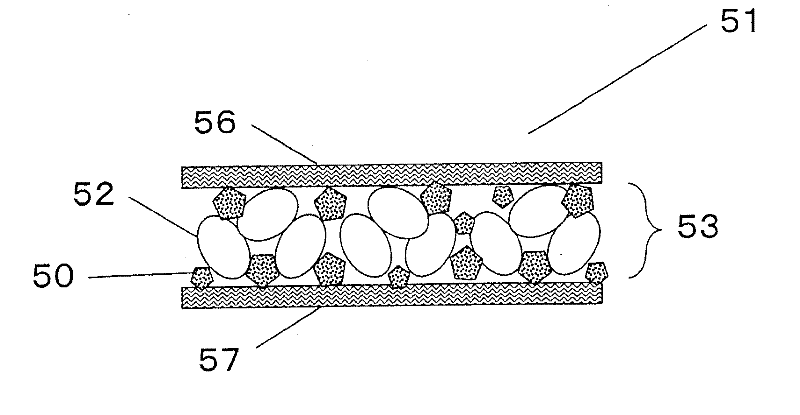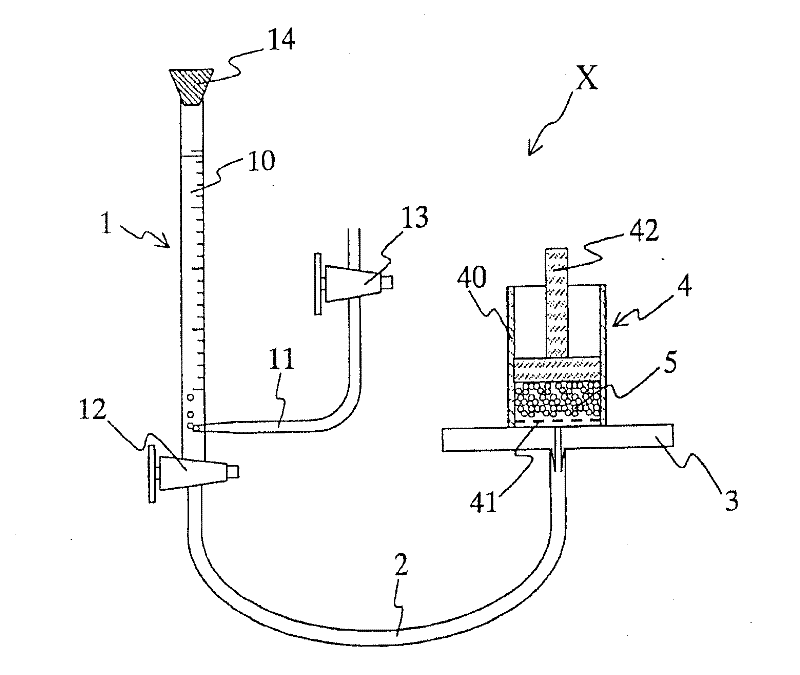Water-absorbable sheet structure
A water-absorbing sheet, water-absorbing technology, applied in the direction of absorbent pads, synthetic resin layered products, textiles, etc., can solve the problems of slow penetration of the absorber, reduced liquid diffusivity, gel blockage, etc., and achieve shape retention. Good, excellent creative appearance, no effect of back seepage and leakage
- Summary
- Abstract
- Description
- Claims
- Application Information
AI Technical Summary
Problems solved by technology
Method used
Image
Examples
Embodiment
[0085] The present invention will be described in further detail below according to the examples, but the present invention is not limited to the examples.
[0086] The performance of the water-absorbent resin and the water-absorbent sheet structure was measured and evaluated by the following methods.
[0087]
[0088] 2.0 g of the water-absorbent resin was weighed into a cotton bag (No. 60 men blue, width 100 mm×length 200 mm), and put into a 500-mL beaker. Inject 500 g of normal saline (0.9% by mass sodium chloride aqueous solution, the same below) into the cotton bag at one time to disperse the normal saline so that the water-absorbent resin does not agglomerate. Tie the upper part of the cotton bag tightly with a rubber ring and let it stand for 1 hour to fully swell the water-absorbent resin. The cotton bag was dehydrated for 1 minute using a dehydrator set at a centrifugal force of 167G (manufactured by Kokutoshinki Co., Ltd., model: H-122), and the mass Wa (g) of the...
manufacture example 1
[0149] (Manufacturing example 1: water absorbent resin A)
[0150]Prepare a round-bottomed cylindrical separable flask with an inner diameter of 100 mm. The flask is equipped with a reflux condenser, a dropping funnel, a nitrogen gas introduction tube, and a stirring blade as a stirrer. The stirring blade is divided into two stages and has 4 pieces with a blade diameter of 50 mm. Tilt the propellers. Take 500 mL of n-heptane in this flask, add 0.92 g of HLB3 sucrose stearate (manufactured by Mitsubishi Chemical Fursz Co., Ltd., Lyoto-Syuga-Ester S-370) as a surfactant, 0.92 g of maleic anhydride-modified An ethylene-propylene copolymer (HIWEX 1105A, manufactured by Mitsui Chemicals, Ltd.) was heated to 80°C to dissolve the surfactant, and then cooled to 50°C.
[0151] On the other hand, weigh 92 g of 80.5% by mass acrylic acid aqueous solution in a 500 mL Erlenmeyer flask, cool it externally, and simultaneously add 154.1 g of 20.0% by mass sodium hydroxide aqueous solution dr...
manufacture example 2
[0156] (Manufacturing example 2: water absorbent resin B)
[0157] In the above-mentioned Production Example 1, after the water was discharged out of the system by azeotropy, the amount of the 2% aqueous solution of ethylene glycol diglycidyl ether added was changed to 2.21 g. 1 In the same manner, 230.8 g of water-absorbent resin B in the form of aggregated spherical particles was obtained. The properties of the obtained water-absorbent resin B were: mass average particle diameter: 290 μm, water absorption speed of normal saline: 27 seconds, water retention capacity of normal saline: 51 g / g, water absorption capacity of normal saline under a load of 2.07 kPa: 20 mL / g.
PUM
| Property | Measurement | Unit |
|---|---|---|
| peel strength | aaaaa | aaaaa |
| particle size | aaaaa | aaaaa |
| melting point | aaaaa | aaaaa |
Abstract
Description
Claims
Application Information
 Login to View More
Login to View More - R&D
- Intellectual Property
- Life Sciences
- Materials
- Tech Scout
- Unparalleled Data Quality
- Higher Quality Content
- 60% Fewer Hallucinations
Browse by: Latest US Patents, China's latest patents, Technical Efficacy Thesaurus, Application Domain, Technology Topic, Popular Technical Reports.
© 2025 PatSnap. All rights reserved.Legal|Privacy policy|Modern Slavery Act Transparency Statement|Sitemap|About US| Contact US: help@patsnap.com



